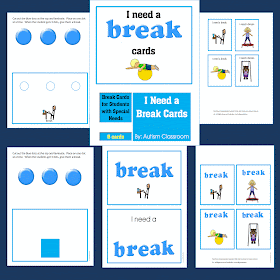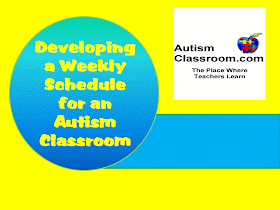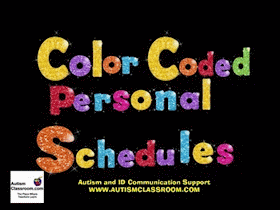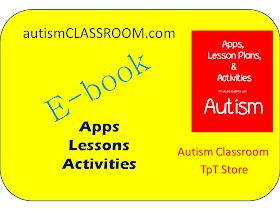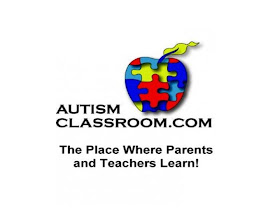Pages
▼
Aug 25, 2014
Aug 22, 2014
Work Tasks for Students with Special Needs
Hands-on work tasks are a necessary and practical item in a special education classroom. Many lessons and skills can be taught using something other than paper and pencil. I think one of my favorite teaching tasks is to find a bunch of supplies and turn them into a task. So I wanted to bring a few of those ideas to you with the hope that they may inspire some tasks that can work well for your students.
Sorting by color.
Matching like pictures.
Match purple and green items.
Match colors.
Match letters of a name.
Place red pipe cleaners in the red container. Place blue in the blue container.
Aug 19, 2014
Back to School Boost Sale
Great news. It is time for another TpT sale. This Back to School boost sale on August 20, 2014 can get you up to 28% off depending on the store. Click below for the Autism Classroom Store.
Enter promo code BOOST at checkout to get the discount.
Enter promo code BOOST at checkout to get the discount.
Aug 16, 2014
I Need a Break! Break Cards for Students with Limited Speech
Once you have created your lovely schedules for your students and you have yous lesson plans all ready to go, all of you students with sit down follow the schedule and have no behavior challenges throughout the entire school day.
WRONG.
Behavior challenges will occur even with super structure and organization. The more consistent you are in providing the right routines, then those behavior will be minimized. But what if a student wants to take a break and they have no words? What will they do? They will get up, they will make a game of it, they will fall to the floor, they may hit, they may throw things, they may put their head down. Then list is endless.
If you want to create a voice for a student who may not yet have speech or who may not always be able to pull out the words they want to say, try using break cards. With a break card, the student can tell the adult "I need a break."
WRONG.
Behavior challenges will occur even with super structure and organization. The more consistent you are in providing the right routines, then those behavior will be minimized. But what if a student wants to take a break and they have no words? What will they do? They will get up, they will make a game of it, they will fall to the floor, they may hit, they may throw things, they may put their head down. Then list is endless.
If you want to create a voice for a student who may not yet have speech or who may not always be able to pull out the words they want to say, try using break cards. With a break card, the student can tell the adult "I need a break."
Only one type of card is need. Just choose the one you prefer. There is also a "working for" card in where the student can earn a certain amount of "tokens" in order to earn the break. They can be laminated and used for the entire school year.
Aug 14, 2014
Setting Up the Autism Classroom: Scheduling Your School Day
Setting up the classroom
can be monumental and at the same time so exciting. It is fun to start a fresh new school year. However, if you are new to teaching or just
new to teaching students with autism, it can be kind of a daunting task to
organize and set up a classroom. That’s where Autism Classroom comes in. Detailed,
step-by-step information about setting up your special education classroom is
in the book How to
Set Up a Classroom for Students with Autism (Second Edition). The
book highlights effective strategies teachers can use to create an effective classroom. One of the top strategies which offers the
most payoff is the use of schedules.
Ebook (Instant Download)
To promote efficiency in the class, a classroom schedule
should reflect most of the following: independent work time, 1:1 (or 2:1) work
time, small group instruction, social skills instruction, sensory play,
structured play/structured recreation-leisure opportunities, fine motor work
opportunities, personal management opportunities, limited large group
activities. These are not set in stone, as
each school and principal will have their own guidelines for classrooms within
their school.
The first schedule I would recommend
putting in place is a tentative weekly schedule. Don’t be stubborn, write it in pencil. Chances
are you will need to erase it several times before it is final. When creating it, think of what activities
you want to occur throughout the school day, which activities have to occur and when
are the pre-scheduled activities such as lunch and specials. Try your best to
get a good block of uninterrupted time in the morning so that you can create
consistency in the student’s morning routine.
For more tips on creating a weekly schedule, see my webpage on the topic by clicking on the picture below.
Here are a few schedule templates
you could use to get you started thinking about what you want to accomplish
during the school day.
Once you know what activities will
occur, you can make student schedules. Schedules can come in many forms. The
most useful for students with autism are those schedules that are visual. This could
mean written, pictures, photos or actual object representations. This schedule provides
the student with picture icons they can use to see what will occur throughout
the day. It can be mounted to folder or
a piece of cards stock to make it sturdy.
This product Color Coded Personal Schedules, available
at the Autism Classroom TpT Store, is an individual schedule that you can add
your own picture icons or objects to. There are 9 colors. You can
choose the colors you like or you can use the blank one and mount it on colored
file folders. 36 Picture icons are included! These schedules can
be used in the home, school and community.
We
know that organizing the day is an effective strategy for working with children
with autism and related special needs. Especially for those who may have
intensive needs. Additionally, making the schedule individualized to fit the
student’s needs (ex. specific sensory breaks) and his/her schedule (ex.
specific speech therapy or reinforcement breaks) can help with behaviors.
Schedules can increase on-task behavior by giving the adult a visual tool to
direct (point) the child back to. Using schedules for students with special
needs offers them a way to navigate transitions a little easier by knowing what
to expect next.
Aug 13, 2014
Apps, Lesson Plans & Activities for Young Students with Autism
It is that time of year. Time to start planning activities and lessons for your students. If you are teaching at home, you might need to plan activities for your little ones. Well, this resource, which is one of my best selling items in my TpT store gives teachers, parents and practitioners starting points and beginning places for planning lessons. (This item is also available in paperback at any major online bookstore.) It is intended for pre-school and elementary-aged students.
 |
| Ebook on TpT |
 |
| Ebook on TpT in Spanish |
This book is gives over 100 starting points and beginning places for creating meaningful activities for pre-school and elementary-aged students with autism and related special needs. The book is in chapters by themes. The themes addressed in the book are:
Colors
Numbers and Shapes
Fall (Sub-theme: All About Me)
Winter (Sub-theme: Winter Holidays)
Spring
Summer (Sub-theme: Camping and Going to the Zoo)
Transportation
Mobile Apps
To help pinpoint skills even better, each chapter has a list of activities that address some of the skills that are sometimes the most challenging for some individuals with autism such as:
Joint Attention
Imitation Skills
Communication
Self-Help Skills
Independent Skills
Pre-Vocational Skills
Social Skills
Play Skills
Sensory Involvement
Basic Concept Mastery
Vocabulary/Literacy
Fine Motor
Gross Motor
At the end of each chapter there is an "Implementation Tip" related to one of the activities in that chapter. Sample lesson plans for creating classroom routines and classroom procedures are provided in the book as well. The paperback can be bought at online books stores or in bulk on TpT:
Additionally, the “Apps” chapter highlights 10 educational apps in each skill area. That is over 100 apps! The highlighted apps can be easily incorporated into lessons and activities for young children. Suggestions are provided for how to use that app within your lesson.
Examples from the chapter on apps:
Imitation Skills/Matching
•Talking Ben (Outfit7, Free)- Have fun letting Ben imitate words and sounds that your class or your family makes.
Fine Motor
•iBuild ABC’s (Chris Kieffer, $0.99)- Build ABC‟s on the app, then have students use their bodies to make large letters on the carpet.
Independent Skills/ Pre-Vocational Skills
•More Cookies! (Maverick Software LLC, $0.99)- Practice mixing, baking and decorating cookies on the app for a few days. Culminate the lesson by applying the skills learned to a real cookie baking session.
Click to See Details
Setting Up an Autism Classroom On a Budget Series (Part 5 of 5)
Play time, sensory time and computer time.
Play
time and leisure time products can be costly, but here are some tips for easing
the burden on the wallet. Classroom teams can shop yard sales for “fidget” toys
and age appropriate toys. A favorite yard sale find are the small wind-up toys
usually found in kids meals at various fast food restaurants. They make great
reinforcers and motivators for children (be sure to monitor their use closely
if any students are prone to place things in their mouth.) At yard sales,
sometimes someone may be willing to let go of a huge bag of these items for as
little as $5.00. Swapping toys on a rotating basis with another classroom
teacher in the building can help save some money as well. Additionally, games
such as a matching game can be made pretty inexpensively using two identical
decks of cards from the dollar store (shapes cards, letter cards, number cards,
etc.) This theory works the same for paint “chips” from the hardware store or
identical photographs, both of which can make simple matching games. File folder games
are easy to store and easy to create. Simply take one set of matching game
cards, glue it to a file folder, laminate and you have a sturdy teaching
material. See this cute example of my Dalmation File Folder Game. Or for the
teens and young adults, see this Teen Real Sports File Folder Game
To
assist with purchasing items for a sensory area in the classroom, teachers can
ask parents or community supporters to send in items for a sensory area (ex.
lotion, shaving cream, finger paint, weighted blankets.) If that is not
possible, making sensory items may be the best solution. For example, a
“weighted sock” can be created using tube socks and dry rice. Also, a teacher
can try using three or four pillows inside of a sewn sheet as a sensory body
pillow. If tactile sensory items are needed, creating a “squishy” toy using
finger paint inside of a zippered baggie may just work. Just be sure to secure
it with several baggies, duct tape and adult supervision!
Computers can offer value too. Teachers
needing to create an autism classroom on a budget should take advantage of many
of the free and low cost materials offered via the internet. For students, ZAC Browser (Zone
for Autistic Children) is an internet browser that offers safe connections to
websites for children with autism. Starfall.com is website for young children
working on alphabet and reading skills. These are only two sites out of many
that teachers can utilize for free.
For the adults on the classroom team, the
internet offers a variety of free trainings related to autism. For example, AutismSpot.com,
AutismClassroom.com, PostivelyAutism.com and all offer training and or videos
with great information for educators and parents too. A fairly new site,
AutismInternetModules.org, offers a full array of over 45 in-depth self-paced
training modules that educators can take over the web. Lastly, low-cost books
such as How to Set Up a Classroom for Students with Autism: 2ndEdition and How Do I Teach This Kid provide invaluable tips for little cost.
These tips will hopefully help add substance to the classroom while keeping the
money in the pocket!
Aug 12, 2014
Setting Up an Autism Classroom On a Budget Series (Part 4 of 5)
Communication.
Communication
is a huge deal in a classroom for students with autism. The goal is always to
increase the student's ability to express and receive a message. There are some
ways to do this without spending a lot of money. To start with, a person can
print picture icons in black and white, instead of color, to save on ink. Next,
they can try using an internet search to find images for communication tools.
They just need to be sure that it is a clear picture of just the item and it
does not have anything in the background. Another option is to take your own
photo of the item in question. Additionally, teachers can save loads of money
by using the real object as a communication tool or by using a cut out of the
actual package of the product. The cut out can be laminated or placed in a
zippered baggie and exchanged back and forth for students who may be non-verbal
or who may use limited speech.
To
increase communication in students with limited speech, teachers can use pocket
photo albums as communication books. They are found at most dollar stores, they
are lightweight, and they can have picture cards inserted and removed easily.
Schedules, which are needed in many autism classrooms, can be made using card
stock paper or file folders. Finally, communication costs can be lowered by the
teacher bringing in real items from home when teaching concepts in a specific
lesson. This has an added benefit of providing a hands-on experience for the
students. I have a few communication building products in my TpT Store.
The first is a set of communication supports for opening circle time. They will help to build language and also help some students to understand by seeing the pictures.
The second set is meant to help students self-advocate by making choices. The Choice board can be found here.
The first is a set of communication supports for opening circle time. They will help to build language and also help some students to understand by seeing the pictures.
Aug 11, 2014
Setting Up an Autism Classroom On a Budget Series (Part 3 of 5)
Supplies.
Supplies for the classroom cost teachers so much money. For classroom set up, teachers
should make use of the numerous websites that provide free materials. Download
free materials, schedules, data sheets and visual supports on sites like I have here are AutismClassroom.com:
Classroom
organization can present some ways to save as well. First and foremost, a
teacher can use dollar store tubs as storage bins for storing student work,
lessons plan materials and more. Zipper baggies of various sizes come in handy
for just about every aspect of the classroom environment. The smaller baggies
make great storage for flash cards, and the jumbo bags can be used as a reward/reinforcer
bag to store large toys or to store extra clothing or student’s personal
belongings. Similarly, reusable food storage containers of all sizes, double as
toy storage containers, art supplies containers, reward containers and work bin
containers. If bigger containers are needed, check for back to school sales on
Rubbermaid-type 20 gallon containers, which can be as low as $4.00 each.
Buying
pocket folders when on sale (at back to school time) is another way to save.
Many times you can get folders for 5 cents or 10 cents in early August at
office supply stores. In addition, we know that data binders are an important
tool in organizing the student's progress on their personal goals. Educators
can make dividers for the student’s binders by using colored construction paper
or card stock paper instead of buying pre-made tab dividers. If a teacher is
savvy with the computer, he or she can create their own free data sheets using
the “Create Table’ section of a word processing program or do an internet
search for “data sheets” to find some freebies that fit the needs of your
students. There are a few data collection sheets here.
Recycling
old binders to use for the students data binders or asking the principal or
other teachers if they have any unused binders can also save loads of cash.
If
a classroom has no shelf space, recycle old sturdy bookshelves to use as
shelving if needed. Classroom organization can also be helped a bit by asking
parents to send in old, cleaned containers such as margarine, butter, or
oatmeal containers. These items can be used to store toys or to store puzzle
pieces or small pieces for work tasks.
Aug 9, 2014
Setting Up an Autism Classroom On a Budget Series (Part 2 of 5)
Furniture.
It is kind of hard to set up a room without furniture if your classroom does not have much, but there are a few tricks that can be used to save. Furniture, of course can be costly, however, recycling can be called to play by using old sturdy bookshelves as a storage place for a materials for a work station and centers. Teacher's desks should never be the focal point of a classroom, especially in a classroom teaching students with autism. However, if a desk must remain in the room, a teacher can set up the teacher's desk in such a way that it doubles as a divider. For example, the desk can help to create a division in the room which allows for various areas like an independent work area or a play area.
It is kind of hard to set up a room without furniture if your classroom does not have much, but there are a few tricks that can be used to save. Furniture, of course can be costly, however, recycling can be called to play by using old sturdy bookshelves as a storage place for a materials for a work station and centers. Teacher's desks should never be the focal point of a classroom, especially in a classroom teaching students with autism. However, if a desk must remain in the room, a teacher can set up the teacher's desk in such a way that it doubles as a divider. For example, the desk can help to create a division in the room which allows for various areas like an independent work area or a play area.
When
creating a division in the room, it is usually common that one would use heavy
partitions or study carrels which can cost hundreds of dollars. To save some
cash, use cardboard or corrugated dividers instead of expensive partitions.
Dividers like these can be found at Calloway House Inc., a website that sells
classroom products.
These dividers are light-weight and can be removed and
stored away easily or can be secured by placing something such as a desk or
table on both sides of them to help them stay up. You always have to be careful
to have items that do not tip over easy, especially if you have a student that
may like to throw or push things.
Custodians can be very helpful in setting up the classroom. Asking the custodian in the school if they know of any "hidden' desks, chairs, tables or partitions works for me. They are the go-to people with the knowledge of what is going on furniture-wise for that building. File cabinets are also items that may already be in the school and may be able to help create the areas of the classroom you want to create. Just ask if there are any file cabinets that you can use to create centers for your classroom. Asking the custodians is a sure way to save some money and time. You might be surprised what they come up with!
Aug 7, 2014
Setting Up an Autism Classroom On a Budget Series (Part 1 of 5)
I
have written about this topic before, but I didn’t have a “proper” blog, as
they say. Also, this topic is timeless since every year a classroom has to be
set up and every year, saving money in the process is favorable. So here is
goes again. We do know that if you let
it, setting up a classroom for students with autism can be time consuming and
expensive. In today’s economy, with budget cuts and school districts cutting
back on expenses, that challenge is intensified. From communication tools to printables
and apps, the price list seems endless. However, there are many ways that a
person can create a useful and effective autism classroom on a budget.
Designing the classroom is an important element in creating the type of room
that fosters successful students. Here are some creative ways to save dollars
on the materials and items used to design the classroom.
When
designing a room, a teacher can use dollar store templates for creating name
cards instead of buying expensive name cards. Or, just print out your own using
a really cool font. Clear packing tape can be used to “laminate” items by
sticking the tape to both sides of the item. Teachers who currently teach in a
school that they will be returning to the next year can ask the administrators
if they can check the school art closet at the end of the school year to
prepare for next year. There are usually a bunch of items in the art closet
that are just sitting there waiting to be used to create useful materials. For
example, construction paper, 3-hole punch devices, glitter, finger paint,
scissors, clip boards, permanent markers, note pads, folders, tape, poster
board, staplers and other good finds are just waiting. Just ask the principal
or secretary if it is alright to take a look in preparation for the school
year.
Index
cards are another item that are inexpensive, but can reap large benefits. Index
cards can be used to make a number of teacher-made items such as matching
games, alphabet flash cards, number cards, picture identification cards, labels
for bins and more. Simply use a permanent marker and good handwriting (or if
handwriting is a problem, print out what you want on the computer and glue it
to the index card) and you have teaching materials that are also easily
replaceable.
Decorating
can be cheap too. Teachers can start by making their own bulletin board
boarders by using construction paper strips and gluing on small designs created
by the students. (This can be done as an art lesson with the students.)
Bulletin board paper can be used in other ways too. If needed, a teacher can
use bulletin board paper to cover distracting items or shelves that appear
cluttered. If a teacher's school will not order one of those expensive carpets
from a catalog or an online store, he or she can try putting together two or
three “furry blankets” from a discount store like Marshall's, TJ Maxx or Ross.
Aug 5, 2014
Back to School Sale
The big Back to School Sale was going on at TpT on August 4 & 5, 2014. It was great. Can't wait for the next sale.
Check out the Autism Classroom TpT Store for details.
Aug 3, 2014
The Teacher as a Leader Series (Part 10: Educational Implications - Autism)
The Teacher as a Leader Series was created as a
guide for teachers to help conduct small scale (team meetings) or large scale
(group presentations) professional development exercises with the other members
of their classroom team or other members of their school team. The series aims
to give a starting point for discussion and guidance on topic that will
ultimately help to improve the capacity for teaching special learners for the
teacher, paraprofessional and 1:1 assistant at the school level, while also improving
student outcomes.
This is part 10 of a 10 part series: Educational
Implications for Students with Autism. There are many
educational implications to consider when working with students with autism. For
example, when running an autism classroom, you must pay attention to preparing the classroom in an organized manner, providing visual
supports that students can use, teaching social
skills, increasing self- help skills and understanding student’s sensory challenges.
Each of these topics is discussed in the presentation. Just click on the picture below for more
details.
Here is an example of one the discussion points from one of the slides in the presentation. When preparing the classroom, be sure to put time into the layout of the classroom. It is just as important to student success as lesson plans. You will want to create clear visual boundaries in the room so that students can see where to go. It helps to make use of carpets, tape, furniture help create boundaries. If you can, have different areas of the classroom labeled and available for students to transition to throughout the day instead of having them stay in the same place. Another way to prepare for students is to clearly define the child’s desk, chair or belongings with pictures, color-coding, names, etc.
This freebie
can be used for personal use of for professional use to present to a group. Enjoy, and thank you for teaching children with autism.
Aug 1, 2014
Teacher as a Leader Series (Part 9: Writing a Behavior Intervention Plan)
Behavior plans are needed for a number of reasons and may vary in intensity and scope. A Behavior Intervention
Plan (BIP or BP) is a written list of strategies and supports for an individual
that encourages
appropriate behaviors and discourages inappropriate behaviors. A Behavior Intervention
Plan is created AFTER a Functional Behavior Assessment is conducted which helps
identify the function of the behavior. A BIP or set of
strategies should be written for each targeted behavior. Since each behavior
may serve a different function for the
student, your response should
vary based on the function
of the behavior.
There are many ways to write a Behavior Intervention Plan. Work with your school team to determine the best style of plan for each individual student. In either case, the plan should focus on two key elements. See the two elements and the slides that describe them below.
 |
| The Teacher as a Leader Presentation Part 9 |
There are many ways to write a Behavior Intervention Plan. Work with your school team to determine the best style of plan for each individual student. In either case, the plan should focus on two key elements. See the two elements and the slides that describe them below.
Strategies to Increase Appropriate Behaviors
 |
| A slide from the presentation. |
Strategies to Decrease Inappropriate Behaviors
 |
| To see more, click on the above picture of the slide. |















